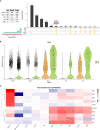Single-cell RNA sequencing of CSF reveals neuroprotective RAC1+ NK cells in Parkinson's disease
- PMID: 36211372
- PMCID: PMC9532252
- DOI: 10.3389/fimmu.2022.992505
Single-cell RNA sequencing of CSF reveals neuroprotective RAC1+ NK cells in Parkinson's disease
Abstract
Brain infiltration of the natural killer (NK) cells has been observed in several neurodegenerative disorders, including Parkinson's disease (PD). In a mouse model of α-synucleinopathy, it has been shown that NK cells help in clearing α-synuclein (α-syn) aggregates. This study aimed to investigate the molecular mechanisms underlying the brain infiltration of NK cells in PD. Immunofluorescence assay was performed using the anti-NKp46 antibody to detect NK cells in the brain of PD model mice. Next, we analyzed the publicly available single-cell RNA sequencing (scRNA-seq) data (GSE141578) of the cerebrospinal fluid (CSF) from patients with PD to characterize the CSF immune landscape in PD. Results showed that NK cells infiltrate the substantia nigra (SN) of 1-methyl-4-phenyl-1,2,3,6-tetrahydropyridine (MPTP)-induced PD model mice and colocalize with dopaminergic neurons and α-syn. Moreover, the ratio of NK cells was found to be increased in the CSF of PD patients. Analysis of the scRNA-seq data revealed that Rac family small GTPase 1 (RAC1) was the most significantly upregulated gene in NK cells from PD patients. Furthermore, genes involved in regulating SN development were enriched in RAC1+ NK cells and these cells showed increased brain infiltration in MPTP-induced PD mice. In conclusion, NK cells actively home to the SN of PD model mice and RAC1 might be involved in regulating this process. Moreover, RAC1+ NK cells play a neuroprotective role in PD.
Keywords: NK cells; Parkinson’s disease; RAC1; brain infiltration; single-cell RNA sequencing.
Copyright © 2022 Guan, Liu, Mu, Hu, Xie, Cheng and Wang.
Conflict of interest statement
The authors declare that the research was conducted in the absence of any commercial or financial relationships that could be construed as a potential conflict of interest.
Figures





Similar articles
-
Association between Decreased ITGA7 Levels and Increased Muscle α-Synuclein in an MPTP-Induced Mouse Model of Parkinson's Disease.Int J Mol Sci. 2022 May 18;23(10):5646. doi: 10.3390/ijms23105646. Int J Mol Sci. 2022. PMID: 35628462 Free PMC article.
-
Decrease in ITGA7 Levels Is Associated with an Increase in α-Synuclein Levels in an MPTP-Induced Parkinson's Disease Mouse Model and SH-SY5Y Cells.Int J Mol Sci. 2021 Nov 23;22(23):12616. doi: 10.3390/ijms222312616. Int J Mol Sci. 2021. PMID: 34884422 Free PMC article.
-
Mulberry fruit ameliorates Parkinson's-disease-related pathology by reducing α-synuclein and ubiquitin levels in a 1-methyl-4-phenyl-1,2,3,6-tetrahydropyridine/probenecid model.J Nutr Biochem. 2017 Jan;39:15-21. doi: 10.1016/j.jnutbio.2016.08.014. Epub 2016 Sep 22. J Nutr Biochem. 2017. PMID: 27741433
-
New Insights and Implications of Natural Killer Cells in Parkinson's Disease.J Parkinsons Dis. 2022;12(s1):S83-S92. doi: 10.3233/JPD-223212. J Parkinsons Dis. 2022. PMID: 35570499 Free PMC article. Review.
-
alpha-Synuclein- and MPTP-generated rodent models of Parkinson's disease and the study of extracellular striatal dopamine dynamics: a microdialysis approach.CNS Neurol Disord Drug Targets. 2010 Aug;9(4):482-90. doi: 10.2174/187152710791556177. CNS Neurol Disord Drug Targets. 2010. PMID: 20522009 Review.
Cited by
-
Hypoxic Natural Killer Cells-Derived HIF-1α-Containing Exosomes Inhibit Cellular Senescence and Apoptosis in Neurocytes to Ameliorate Alzheimer's Disease by Eliminating Oxidative Damages.Mol Neurobiol. 2025 Jun 7. doi: 10.1007/s12035-025-05111-0. Online ahead of print. Mol Neurobiol. 2025. PMID: 40481944
-
Advancements in Single-Cell RNA Sequencing Research for Neurological Diseases.Mol Neurobiol. 2024 Nov;61(11):8797-8819. doi: 10.1007/s12035-024-04126-3. Epub 2024 Apr 2. Mol Neurobiol. 2024. PMID: 38564138 Review.
-
Natural killer cells in the central nervous system.Cell Commun Signal. 2023 Nov 29;21(1):341. doi: 10.1186/s12964-023-01324-9. Cell Commun Signal. 2023. PMID: 38031097 Free PMC article. Review.
-
Aging-related biomarkers for the diagnosis of Parkinson's disease based on bioinformatics analysis and machine learning.Aging (Albany NY). 2024 Sep 10;16(17):12191-12208. doi: 10.18632/aging.205954. Epub 2024 Sep 10. Aging (Albany NY). 2024. PMID: 39264583 Free PMC article.
-
Identification of immune signatures in Parkinson's disease based on co-expression networks.Front Genet. 2023 Jan 17;14:1090382. doi: 10.3389/fgene.2023.1090382. eCollection 2023. Front Genet. 2023. PMID: 36733342 Free PMC article.
References
Publication types
MeSH terms
Substances
LinkOut - more resources
Full Text Sources
Medical
Research Materials
Miscellaneous

